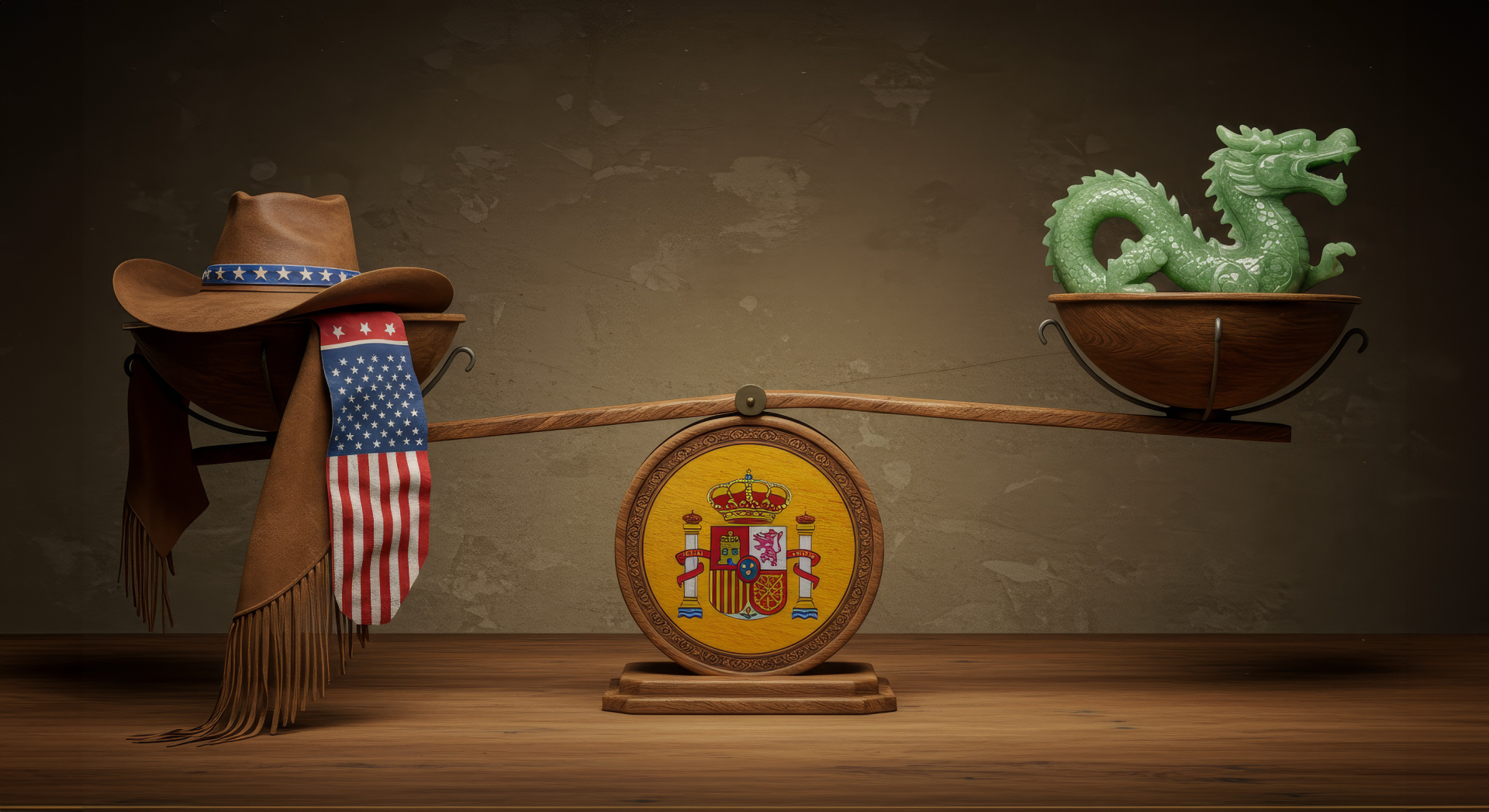Spain’s Balancing Act

Tensions between the US and China have placed Europe at the center of a global trade standoff—but Spain sees this difficult situation as an opportunity. Bolstered by a compromise between the US and China on May 12, in which both countries agreed to suspend their escalating tariff war for 90 days, Spain is pushing for greater EU alignment with Beijing; but to avoid retaliatory measures from the US, Europe must also keep a mercurial Donald Trump on-side. Achieving such a fine balance between the world’s two largest economies, while caught in the middle both literally and figuratively, will not be easy.
Spain’s Socialist prime minister Pedro Sánchez’s visit to Chinese president Xi Jinping in early April, accompanied by agriculture minister Luis Planas, was his third in two years. As the two countries celebrate the 20th anniversary of their comprehensive strategic partnership—signed in 2005 to encourage collaboration in trade, education, and technology—Spanish government spokesperson Pilar Alegría emphasized the “special importance” of the trip and its potential to “diversify markets.” Sánchez’s meeting with Xi resulted in several agreements, one of which extends the thriving Chinese market for Spanish pork products, while another allows cherries to be exported from Spain to China for the first time.
These new agreements will no doubt be regarded with skepticism in Washington. Sánchez’s talks with Xi came shortly after US Treasury Secretary Scott Bessent warned that any European country moving closer to China would be “cutting [its] own throat.” Bessent’s concern is that China, if deterred from the US market by Trump’s punitive tariffs, will saturate the EU with cheap goods, thus harming competition (as has already happened with electric vehicles). When asked about Bessent’s comments on the trip to Vietnam and China, Planas was unfazed: “We have excellent trade relations with China which we intend to not only continue having, but expanding,” he said.
China is Spain’s biggest trading partner outside the EU, and the world’s third-largest consumer of Spanish olive oil, behind the US and Europe. It also accounts for 20% of Spain’s pork exports, worth over €1 billion in 2024. In return, Spain has benefited from a substantial increase in Chinese investment since the financial crisis of 2008–10, when Beijing purchased large chunks of Spanish debt. China is now investing heavily in Spain’s rapidly expanding renewables sector. Last December, the automobile company Stellantis partnered with Chinese battery manufacturer CATL to build a €4.1 billion ($4.3 billion) lithium iron phosphate battery plant in Zaragoza, northern Spain, expected to open by the end of 2026. Last year also saw Chinese companies Envision and Hygreen Energy announce a combined €2.6 billion ($3 billion) investment in green hydrogen infrastructure throughout the country.
Largely as a result of these strong trading and investment ties, Madrid’s attitude towards China has been more friendly than that of the EU leadership. Last October, Spain abstained in a vote on Brussels’s proposal to increase tariffs on Chinese electric vehicles, after an EU investigation found that state subsidies from Beijing were giving domestic manufacturers an unfair advantage over European competitors. But neither the abstention of eleven other nations nor the opposition of five was enough to prevent the EU from increasing tariffs on Chinese electric vehicles up to 45%. In retaliation, Beijing launched anti-dumping investigations into Europe’s pork industry and hiked tariffs on EU brandy up to 39%.
Trump’s tariff onslaught has cooled this nascent trade war, by forcing the EU and China to re-examine their trading ties. Maros Sefcovic, the EU’s commissioner for trade and security, also visited Beijing earlier this year, marking the 50th anniversary of diplomatic ties between Europe and China. In talks with Chinese commerce minister Wang Wentao, Sefcovic stressed the importance of maintaining “a level playing field [between the EU and China], in terms of trade flows as well as investment.” Shortly after, it emerged that both sides were looking at the possibility of a minimum price for Chinese electric vehicles, instead of the tariffs imposed last October. Meanwhile, Spain hopes that its new trading agreements with Beijing might halt the Chinese investigation into Europe’s pork industry, which is due to report its findings this month.
While strengthening trade relations with China, Spain is also trying to keep a wary US on-side. A week after Sánchez met Xi in Beijing, Spanish economy minister Carlos Cuerpo traveled to DC to meet Bessent. Cuerpo described the meeting as “very constructive,” saying that he had defended Spain’s decision to align more closely with China. The US statement, by contrast, referred to it as a “frank discussion” in which Madrid had been urged to increase its defense spending. Cuerpo took that message home: just over a week after the meeting, Sánchez announced a €10.5 billion investment in defense, with which he hopes to reach NATO’s spending target of 2% of GDP by the end of this year—not, as originally planned, by 2029. It has not been revealed what Bessent said to his Spanish counterpart about pursuing closer trade relations with China.
Tariff wars aren’t the only obstacles to closer relations between the EU and China. Europe—and especially Spain—has taken a firmly pro-Ukraine stance since the Russian invasion in 2022, going so far as to discuss forming its own army and unfreezing Russian assets. This sets Brussels against Beijing, at least theoretically. As EU Commission president Ursula von der Leyen said in a 2023 speech: “How China continues to interact with Putin’s war will be a determining factor for EU–China relations going forward.” The EU has also expressed concerns about China’s opaque lending arrangements to developing countries, and its brutal treatment of the mostly-Muslim Uyghur population of Xinjiang.
In a 2021 speech, President Xi declared that any nation attempting to “bully, oppress, or subjugate” China would have its head “bashed bloody against the great wall of steel,” a strikingly violent metaphor in which the country’s most famous monument is equated with its massive army. Interpreted in economic terms, this captures one of the two extremes between which the EU is trying to navigate: get closer and potentially have your throat cut, or push back and risk having your head smashed in. Spain is showing Europe the benefits of moving closer to China, despite the risks; but it remains uncertain whether cordial relations with Trump 2.0 are possible at the same time.
The post Spain’s Balancing Act was first published by the Foundation for Economic Education, and is republished here with permission. Please support their efforts.



